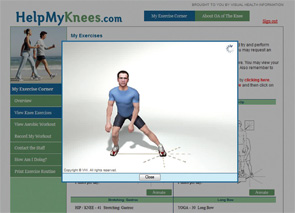
The pain of knee OA can make exercises challenging.
Image Credit: Alice Day/shutterstock.com
Millions of adults suffer from painful knee osteoarthritis (OA). Although physical activity can help improve pain and reduce functional limitations, many people with OA are physically inactive. For people living with knee OA, it can be difficult to get started with or continue on a physical activity program, because pain and other symptoms can make some exercises very challenging. For this reason, it’s important to provide patients with knee OA with guidance and support for an appropriate physical activity program.
Physical Therapy for Knee OA
Visits to physical therapists are one important source for this kind of instruction. Physical therapists can provide guidance on a home exercise program that fits the needs and abilities of each patient with knee OA, including direction on progressing the exercises. Along with this, physical therapists can evaluate whether patients with knee OA could benefit from mobility aids or other devices to address biomechanical issues.
Some studies have shown that physical therapy is an underutilized service among patients with knee OA. Some patients lack health insurance, cannot afford co-payments or live in medically underserved areas where physical therapy services are limited. Thus, there’s a need to develop and test other resources that can provide guidance and support for physical activity tailored for people with knee OA.
The PATH-IN Study
A new study, the PhysicAl THerapy vs. INternet-based Exercise Training for Patients with Knee OA (PATH-IN), is evaluating a newly developed, Internet-based exercise program for people with knee OA.1 The PATH-IN study is based at the Thurston Arthritis Research Center at the University of North Carolina at Chapel Hill, with collaborators at Duke University Medical Center, and is funded by the Patient-Centered Outcomes Research Institute.
PATH-IN is a pragmatic comparative effectiveness trial, in which patients with knee OA are being randomized to usual care physical therapy, an Internet-based exercise training program or a waitlist control group that receives treatment at the end of study participation. The study will examine the effectiveness of each intervention for improving pain and functional outcomes at four-month and 12-month assessment visits. The study will also assess whether the Internet-based exercise training program is as effective as physical therapy, a guideline-recommended component of care for knee OA. If the Internet-based exercise training program is found to be as helpful for knee OA, this would be another treatment option for patients who may not have access to, or be able to afford, physical therapy. This study will also determine whether the Internet-based exercise program is more effective for patients who have certain characteristics (e.g., milder joint disease).

The website being evaluated in the PATH-IN study includes videos that demonstrate proper techniques.
Internet-Based Exercise Program for Knee OA
The Internet-based exercise training program for this study was developed and pilot-tested by Visual Health Information (VHI) Inc., with funds from the National Institutes of Health. VHI is a partner in the PATH-IN study. There are several novel features of this website, which was designed to be a “comprehensive Web-based system to evaluate, prescribe, monitor and adjust therapeutic exercise programs for patients with knee OA.”1 When participants register on this website, they provide information about their pain, function and activity, all of which are used to assign an individualized exercise routine, including stretching, strengthening and aerobic exercises. For example, a participant who begins the program with low function and physical activity may be assigned to a set of exercises in Level 1; this is the easiest level, and many of the strengthening and stretching exercises are completed in a seated or lying position. As participants continue to use the program, they can request more or less challenging exercise programs. As participants progress to higher levels, their exercise routine may contain more difficult exercises, previously assigned exercises with more sets or repetitions and/or an increase in the number of exercises.
For all assigned stretching and strengthening exercises, the website provides videos to demonstrate proper technique (see Figure 1, above). Participants record their exercises on the website, which provides a visual display of their progress over time. To help promote adherence to the physical activity program, the website also sends automated e-mail reminders when participants don’t log onto the website within specified intervals.
A pilot study of this program involved 52 patients with mild to moderate knee OA. Over an eight-week period, there were significant and clinically meaningful improvements in self-reported pain, function, knee self-efficacy and other relevant outcomes among these participants.1 Study participants also reviewed the program positively and used it frequently. Following these promising results, the PATH-IN study is providing an opportunity to further evaluate this website in a rigorous, randomized controlled trial.
Patient-Centered Research Supported by Comprehensive Team
Another exciting aspect of the PATH-IN study is the collaboration among academic research institutions, a company with expertise in rehabilitation/exercise software (VHI), physical therapy clinics, and multiple stakeholders. The physical therapy intervention for PATH-IN is being delivered by multiple clinics serving urban and rural areas of central North Carolina. Physical therapists in these clinics have been key study partners, helping inform the structure of the usual physical therapy intervention so it mirrors routine clinical care, which is important for this pragmatic study. A diverse stakeholder panel is also a key part of this study team, including patients with knee OA (from varying geographic areas served by the study); clinicians with various specialties (e.g., orthopedics, physical therapy, primary care); and representatives of such organizations as the Arthritis Foundation, American Physical Therapy Association, Centers for Disease Control and Prevention, and Department of Veterans Affairs. The perspectives of this group are helping ensure the study is of high relevance to patients and clinicians, and that when complete, it will contribute meaningful evidence about physical activity interventions for knee OA.
 Kelli D. Allen, PhD, is a research professor at the Thurston Arthritis Research Center & Department of Medicine at the University of North Carolina at Chapel Hill and a research health scientist at the Center for Health Services Research in Primary Care at the VA Medical Center in Durham, N.C.
Kelli D. Allen, PhD, is a research professor at the Thurston Arthritis Research Center & Department of Medicine at the University of North Carolina at Chapel Hill and a research health scientist at the Center for Health Services Research in Primary Care at the VA Medical Center in Durham, N.C.
 Yvonne M. Golightly, PT, MS, PhD, is a research assistant professor at the Thurston Arthritis Research Center & Department of Epidemiology at the University of North Carolina at Chapel Hill.
Yvonne M. Golightly, PT, MS, PhD, is a research assistant professor at the Thurston Arthritis Research Center & Department of Epidemiology at the University of North Carolina at Chapel Hill.
 Bryan Heiderscheit, PT, PhD, is a professor in the departments of Orthopedics & Rehabilitation and Biomedical Engineering at the University of Wisconsin-Madison, and co-director of the university’s Neuromuscular Biomechanics Laboratory.
Bryan Heiderscheit, PT, PhD, is a professor in the departments of Orthopedics & Rehabilitation and Biomedical Engineering at the University of Wisconsin-Madison, and co-director of the university’s Neuromuscular Biomechanics Laboratory.
Reference
- Brooks MA, Beaulieu JE, Severson HH, et al. Web-based therapeutic exercise resource center as a treatment for knee osteoarthritis: A prospective cohort pilot study. BMC Musculoskelet Disord. 2014 May 17;15:158. doi: 10.1186/1471-2474-15-158.

